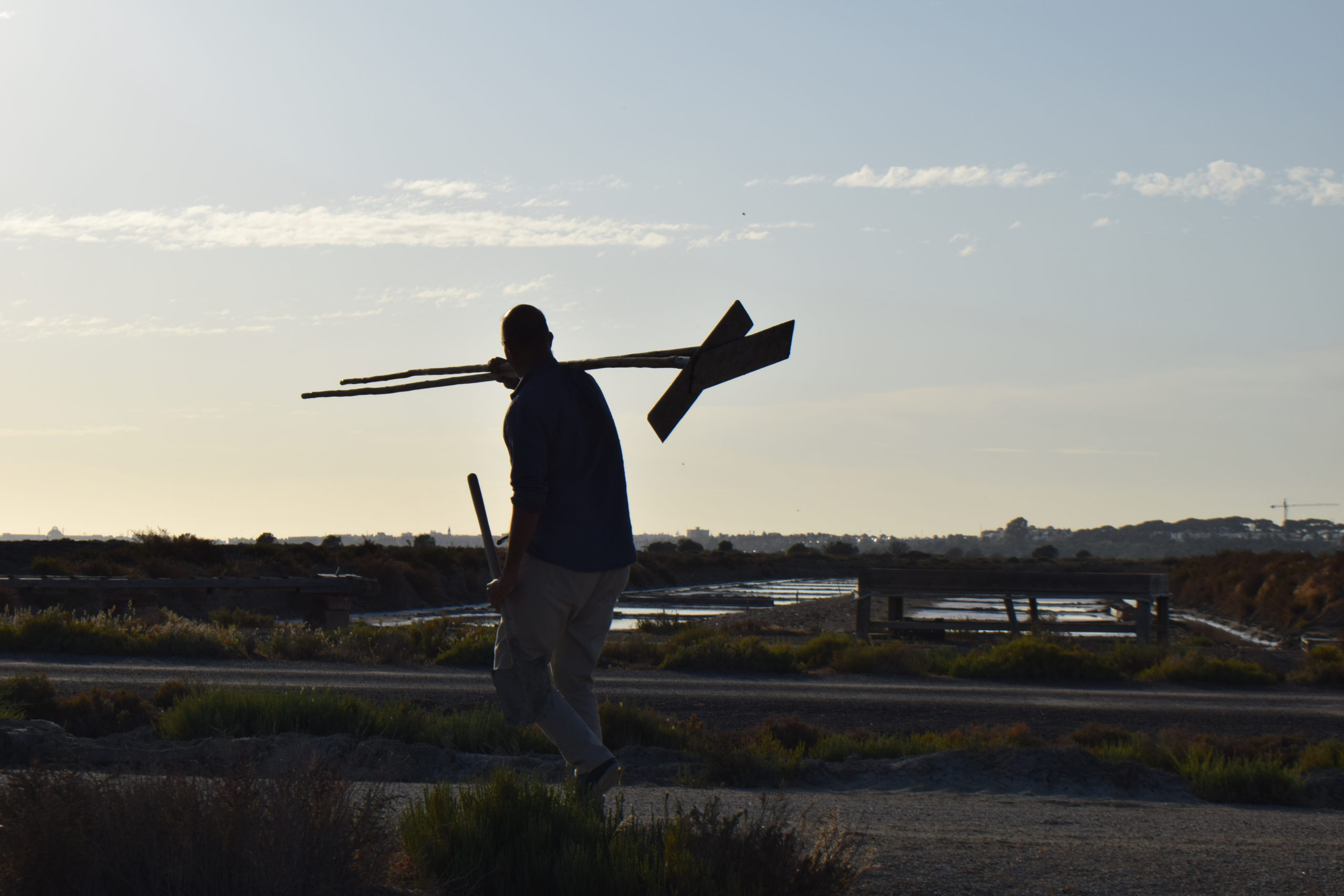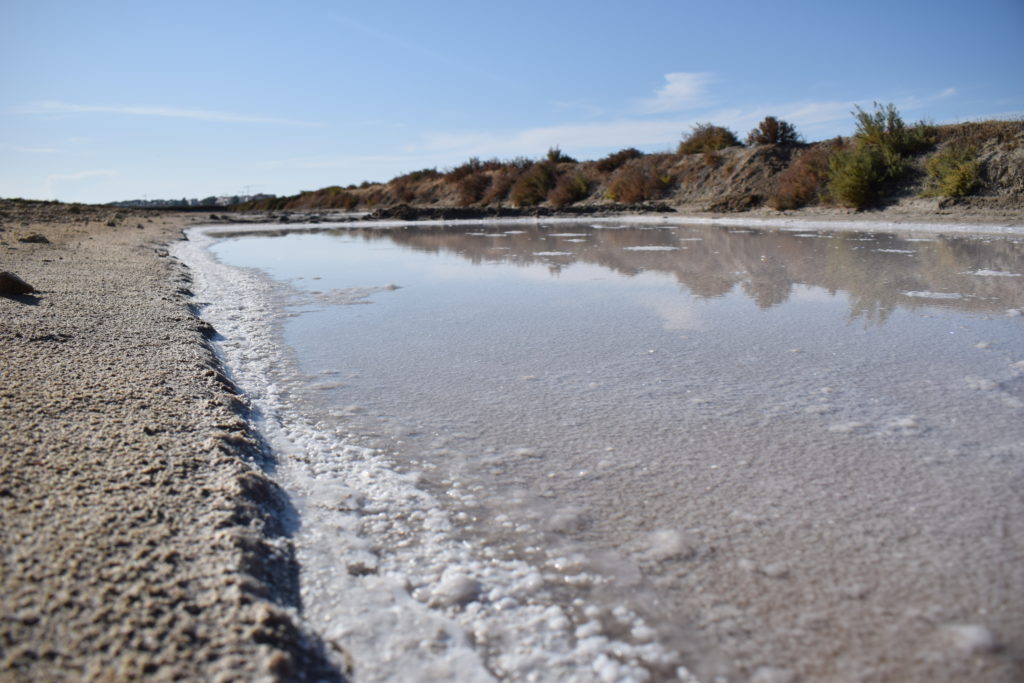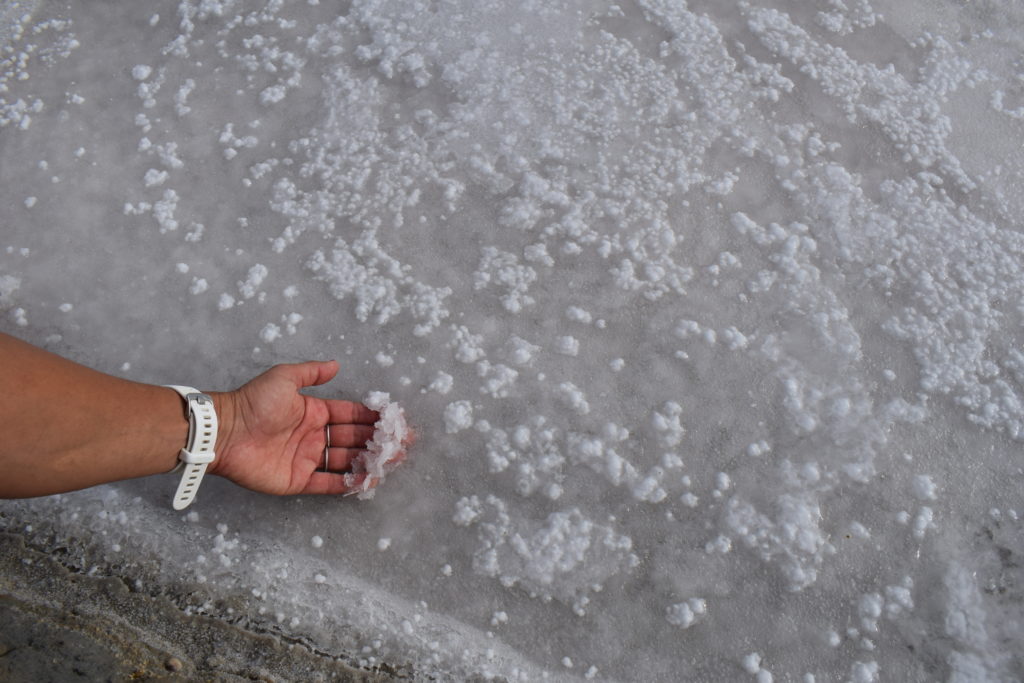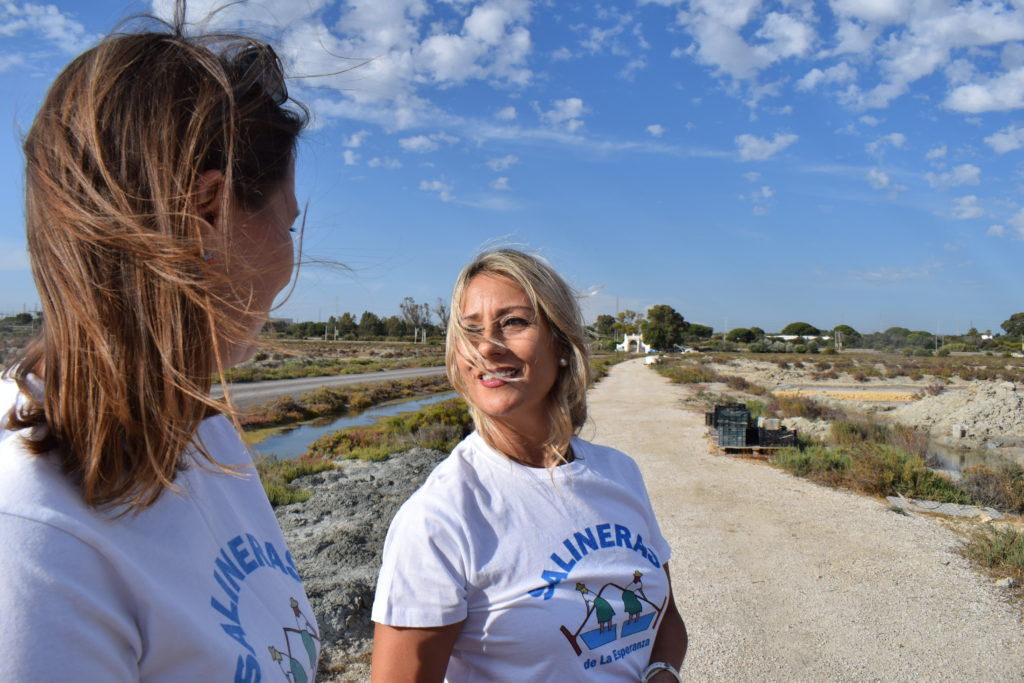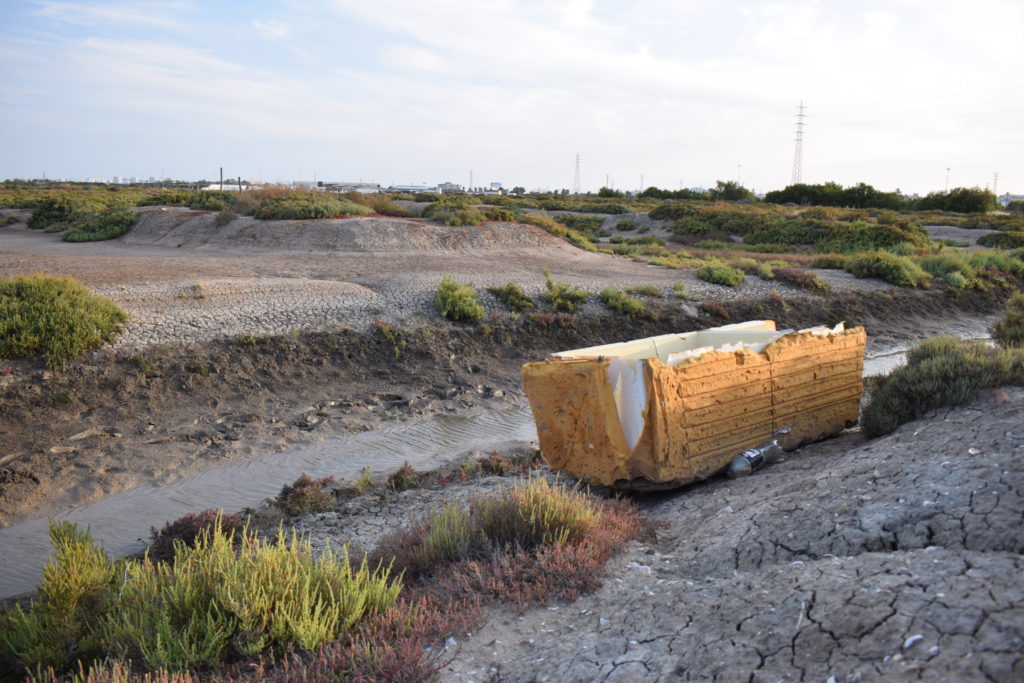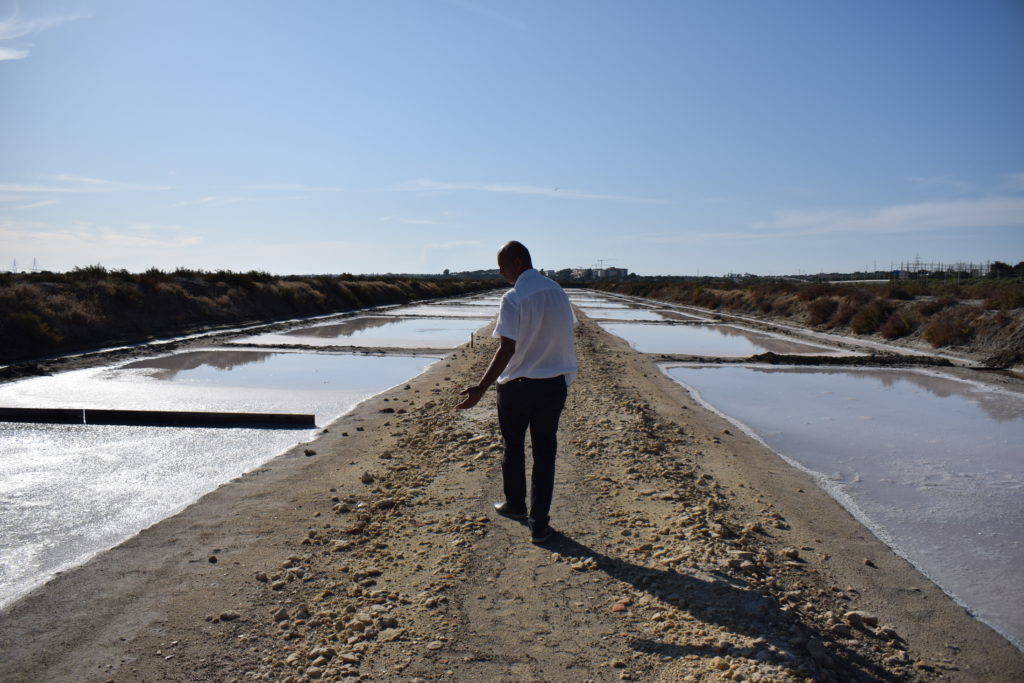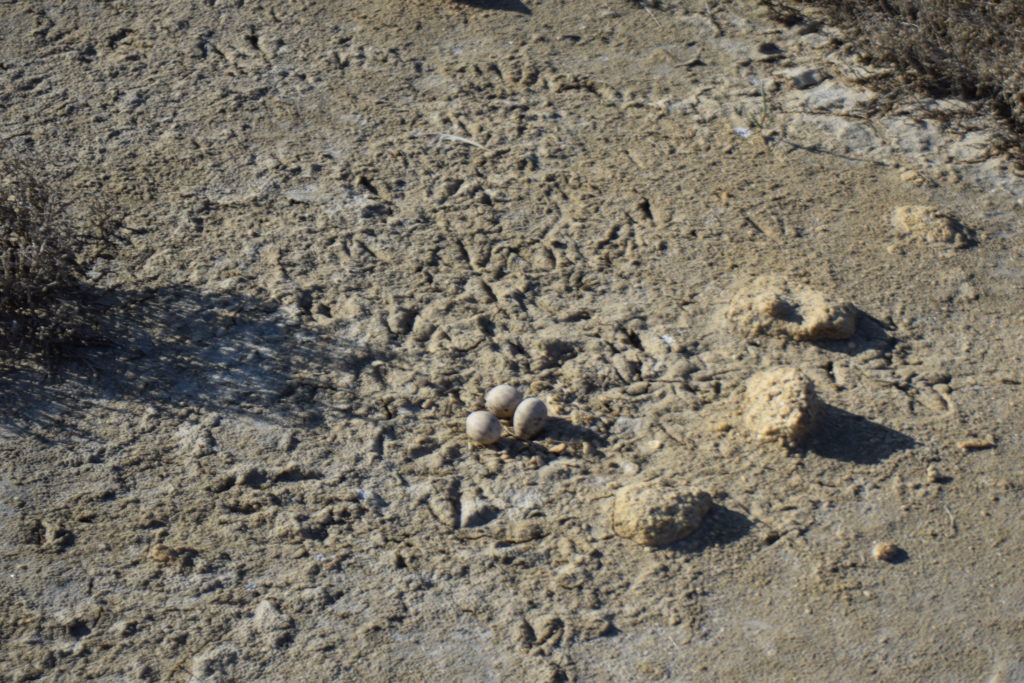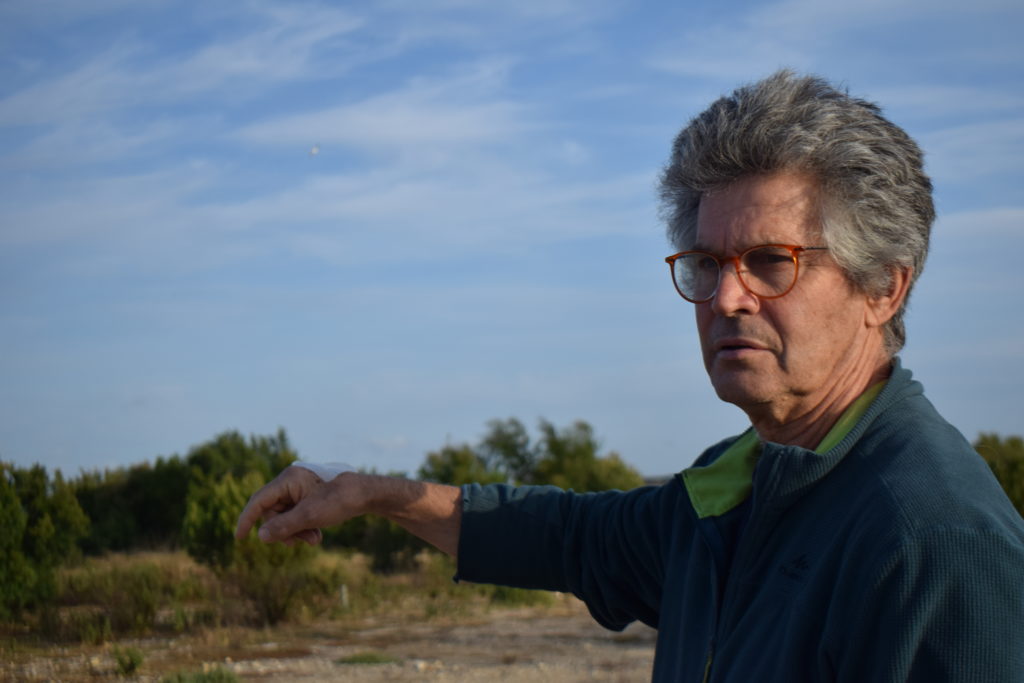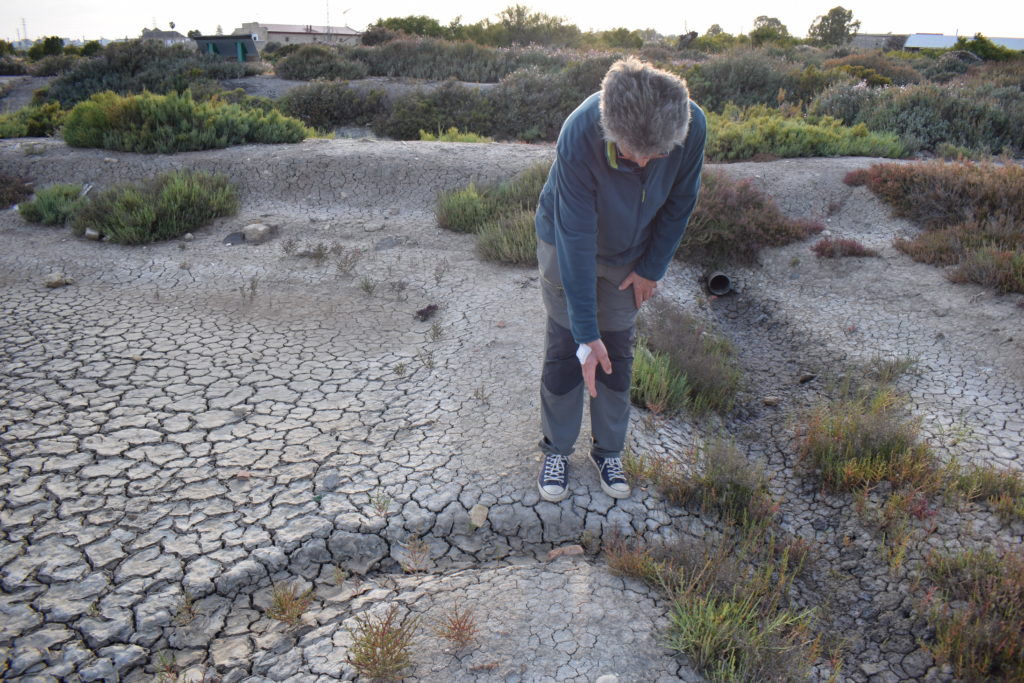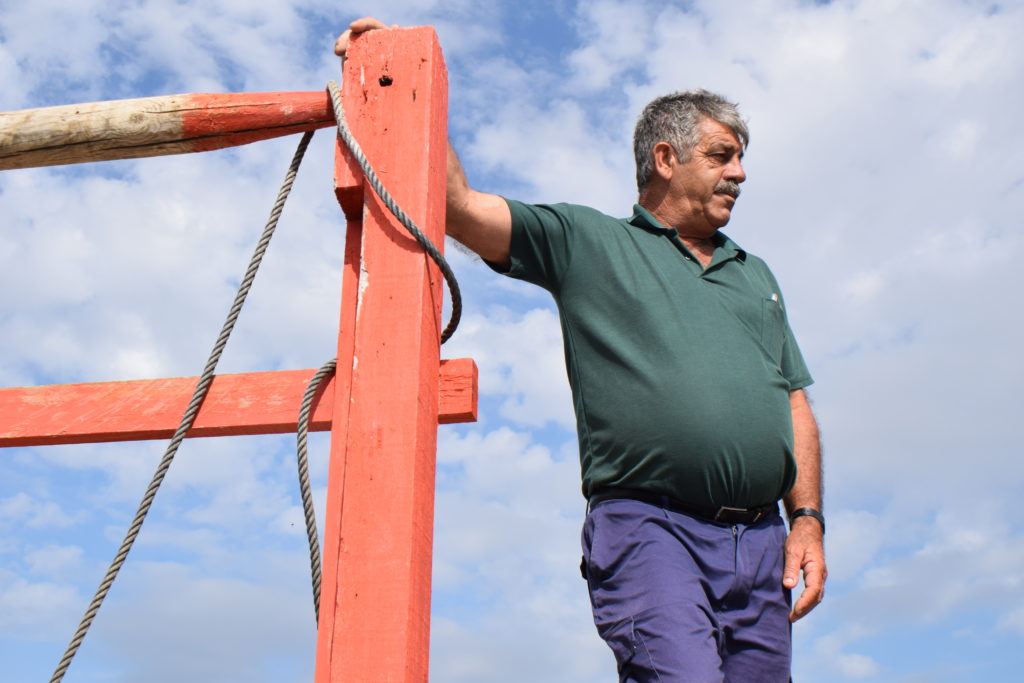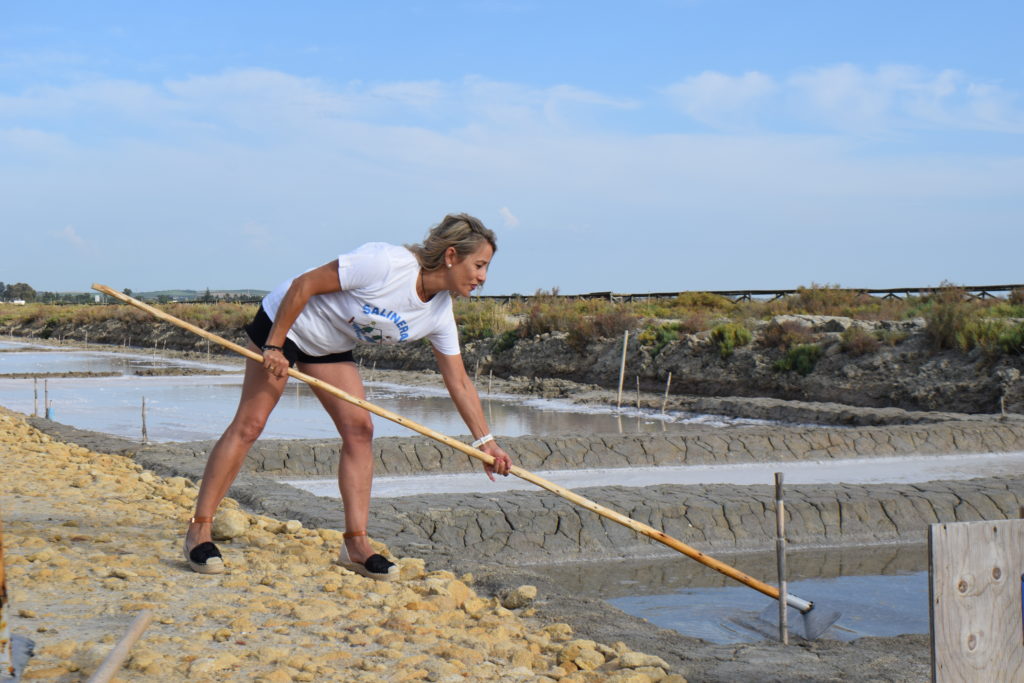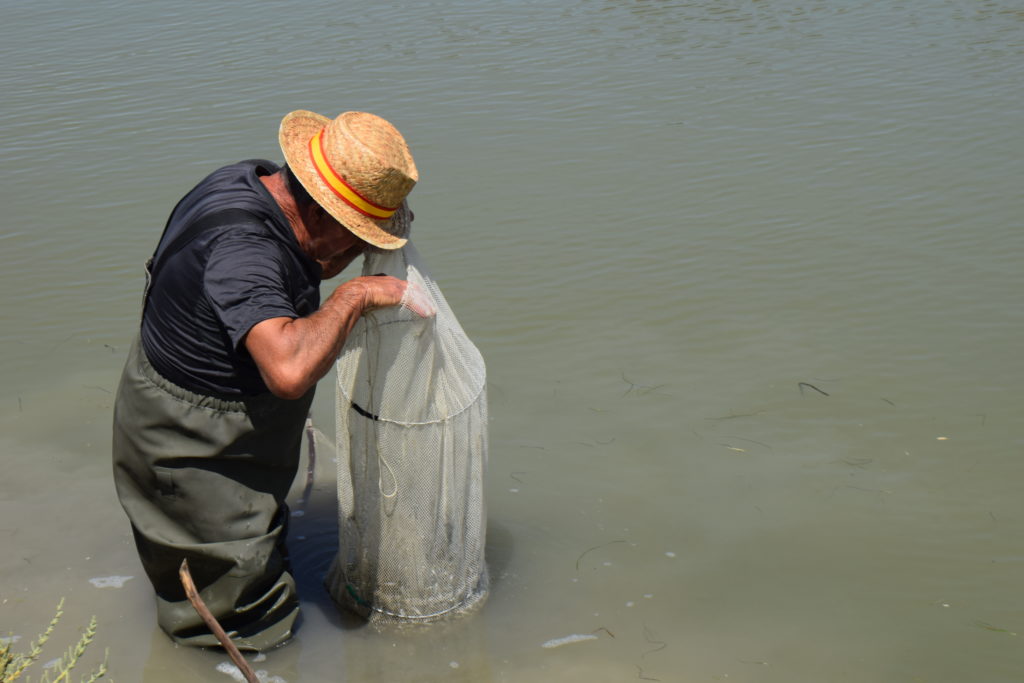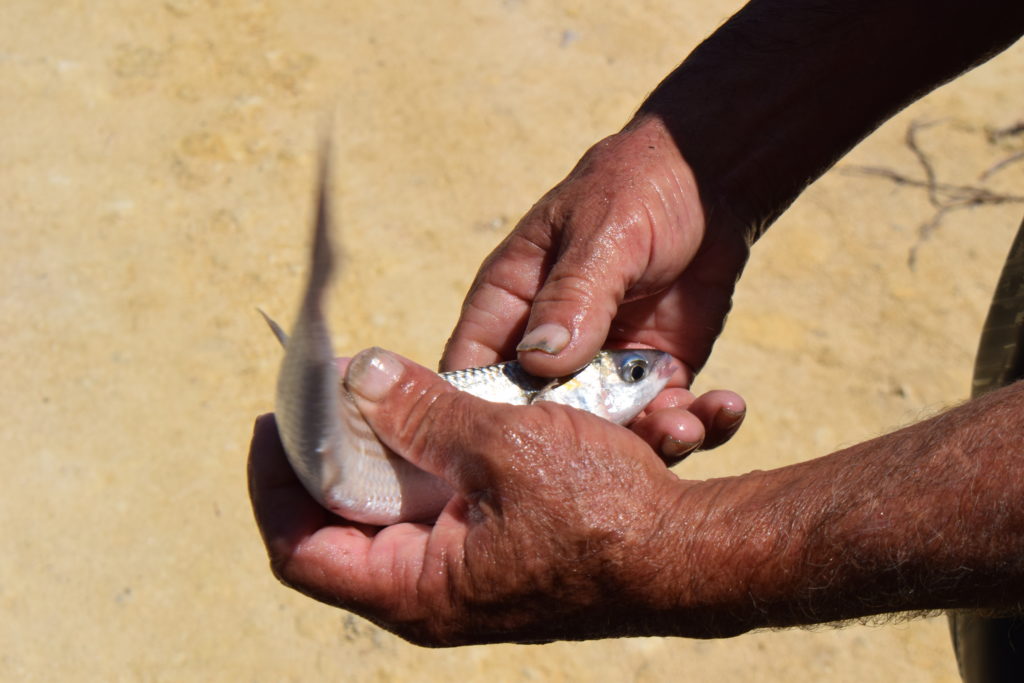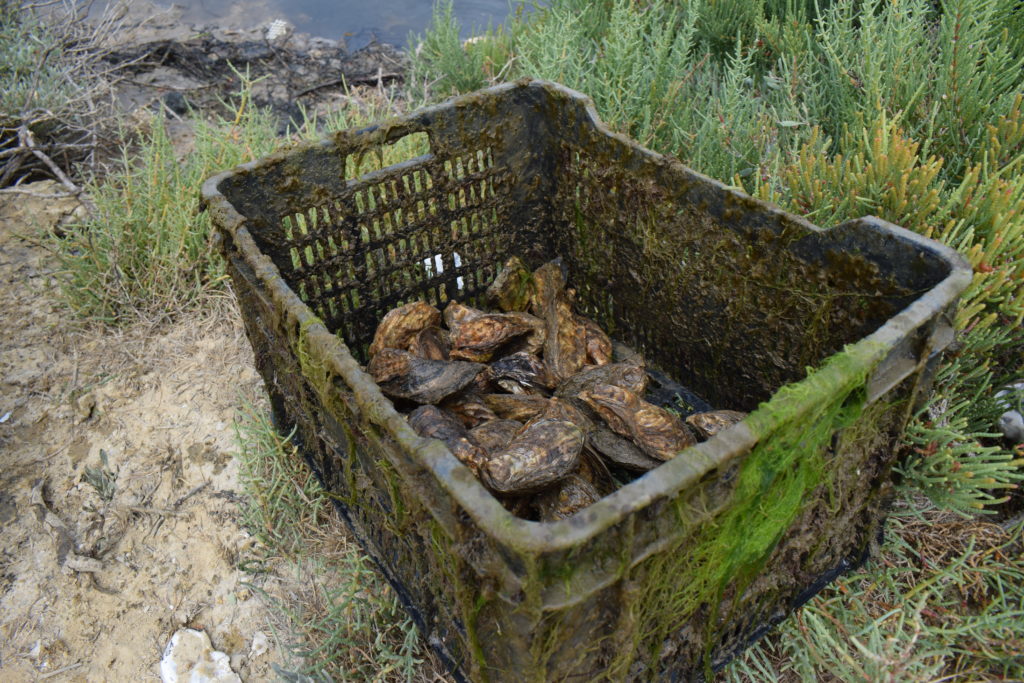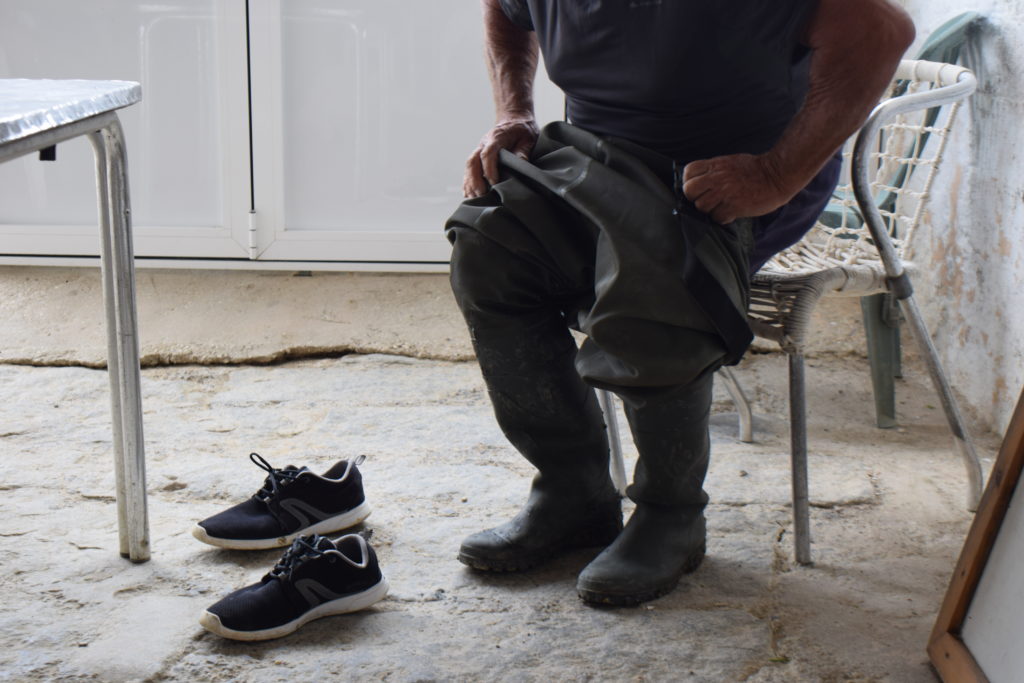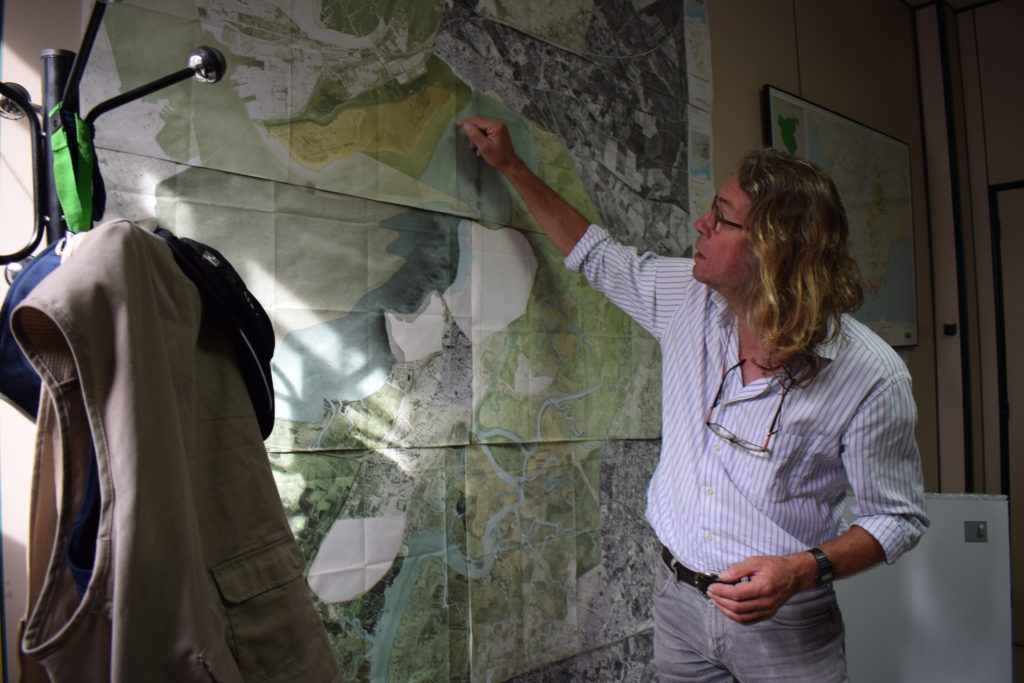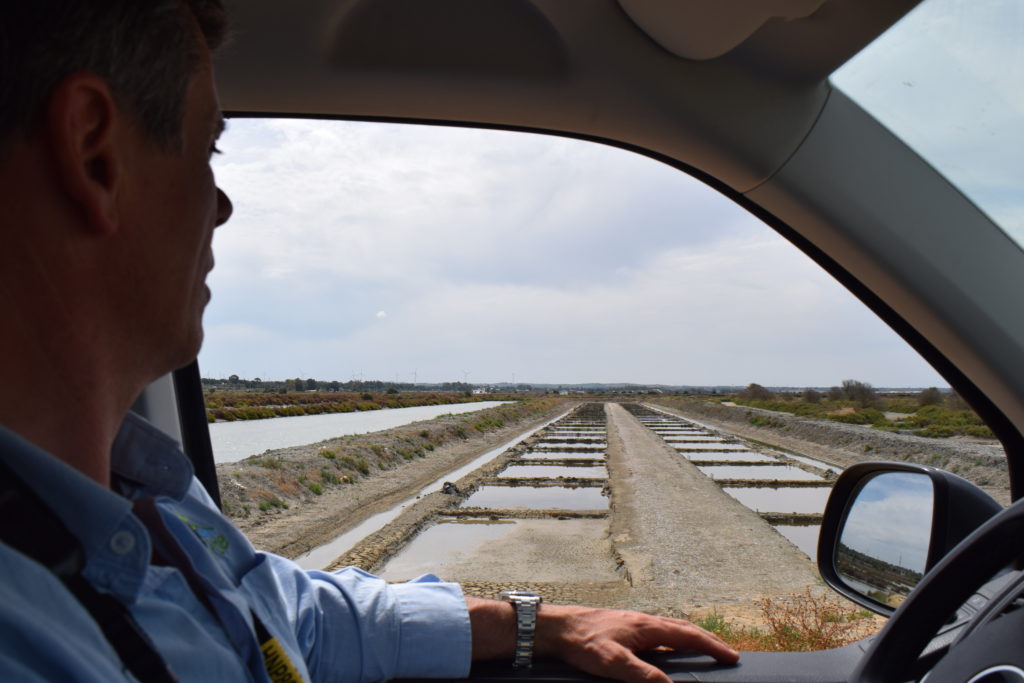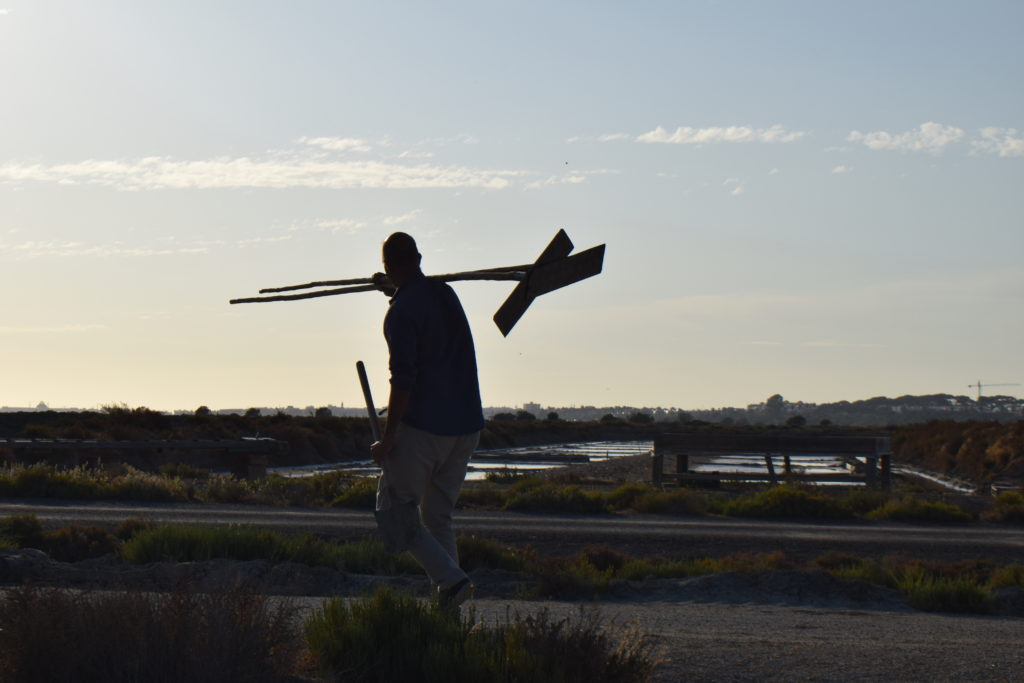In the Bay of Cádiz in the South of Spain, locals have found a way to revive a declining economic sector, adapt to rising sea levels and protect migratory birds: bringing back the traditional salt marshes. Yet amid economic challenges and political efforts to attract foreign investments for a new blue carbon market, reviving the artisanal salt collection is a murky affair.
The seawater feels pleasantly warm. A former environmental educator, Eva María Añino Pedreño, rubs salt flakes between her fingertips, a satisfied smile on her lips. She collects her own ‘fleur de sel’ out of the ‘tajo’ – the traditional name for the ponds used to crystallise sea salt– outdoing her father.
Eva’s father learned the trade of salt collecting from a young age, as was the custom in the Cádiz Bay area, located on the Atlantic coast of Andalucía, Spain. By the age of 9, he had become an ‘hormiguilla’ –a “little ant”–, charged with taking the heavy salt buckets, by donkey, to the markets for sale. But unlike his own father, a lifelong salt worker, Eva’s father was born too late to become a grown ‘salinero’; by the 1950s, the growing popularity of the recently invented refrigerator had led to a rapidly declining salt value –once essential for food preservation–, and the family switched livelihood. “We skipped a generation”, Eva says now. Together with her associate Iryna Lavrentieva, she is taking over after setting up her own business in the recently restored salt pan, La Esperanza.
Disappearing ecosystems
Behind Iryna and Eva, the natural park of the Bay of Cádiz opens out onto the Atlantic Ocean, with an urban setting encircling it on the other side. This is the largest tidal wetland in Spain, protected under numerous international legislations including the EU Natura 2000 Network of biodiversity conservation areas. Most of the 10.5 thousand hectares of the park consists of salt marshes making a watery no-man’s land between the open sea and the coastal, industrial town in the bay.
The neglect of the marshes, long disregarded as smelly and dirty, has raised increasing alarm, as scientists have highlighted their crucial role in mitigating the impacts of the climate crisis. These special ecosystems form natural barriers against rising sea levels, and provide a critical defence against flooding. Moreover, coastal marshlands act as potent carbon sinks, absorbing carbon dioxide ten times faster than mature rainforests.
Between 2000 and 2019, an area the size of two soccer fields was lost every hour, NASA research revealed.
However, wetlands worldwide are under severe threat, with up to 71% already lost to urbanisation, sea-level increases, and erosion since the 1900s. Between 2000 and 2019, an area the size of two football pitches was lost every hour, NASA research revealed. In Cádiz, over 80% of the salt pans are in a state of abandonment and at risk of disappearing, and along with them the livelihoods of traditional salt workers.
In order to preserve both the biodiversity and the heritage of salt pans, local restoration projects have sprung up across the Mediterranean and Atlantic region. In the Bay of Cádiz, among others, a university funded project has restored the once abandoned salt pan, La Esperanza – in Spanish, “Hope”. Artisanal workers, entrepreneurs like Eva and Iryna, and university researchers, collaborate on elaborating market-competitive products while monitoring the local bird fauna.
Their love of being outdoors in nature, as well as their will to reconnect with the local salt heritage, led the two women to sign up to some introductory courses provided by the University of Cádiz to learn about restoration practices. “And now we’ve fallen in love with this place”, Eva says. Iryna nods and laughs, the east wind ruffling her loose hair, “even though we had the same photo, we had to take it again and again”, she says, searching through her camera roll, full of photos of sunsets reflected on the crystallisers.
The decline of the salt pans
A 10-minute-car journey from the small coastal town of Puerto Real and you arrive at ‘La Esperanza’, with its tall, white gate, standing alone in the middle of the Bay. The entrance is a reminder of the importance salt production once held in the province, nowadays one of the areas with the highest unemployment rates in Europe.
At its peak, the Bay exported around 300,000 tonnes of salt a year.
The thousand-year-old artisanal tradition pre-dates the Romans, and by the end of the 19th century more than half of the marshlands in the Bay of Cádiz had been transformed into salt pans, which lined the Gaditan coast with glistening salt pyramids. “My grandmother was born in one of these estuaries. Cádiz was a land of salt mines, it is part of our collective memory, instilled in the Cádiz identity”, remembers Eva, holding her ‘vara’, a lengthy wooden tool to scrape the thick layer of salt that the evaporated water leaves in the crystallisers. At its peak, the Bay exported around 300,000 tonnes of salt a year – 20% of Spain’s national production –, mostly to Northern Europe and America. However, the following decades brought with them rapid deterioration.
A century later, urban construction along the Spanish coast, to both enrich the political elite and meet the demands of the growing tourism industry, meant that some of the marshy lands were paved over. In 1988, following decades of demands by environmental activists all over the country, a new Coastal law was promulgated, declaring the marshands part of the maritime-terrestrial public domain. From that moment on, their use was to be regulated by a public concessions regime. A year later, the Cadiz Bay Natural Park was declared. According to the local activist Juan Clavero, from the environmental NGO Ecologistas en Acción, this prevented the irreversible destruction of the saltmarshes, threatened by concrete. But it did not halt the deterioration of the salt pans which, left unmaintained, dried out, as water escaped back into the ocean or flooded over, their walls crumbling, Clavero explains.
Entire families, just like Eva’s, lost their salt-dependent livelihoods. Some salt pan owners adapted by converting to industrial, machine-driven harvests. More than half turned to aquaculture, changing the landscape once again, while many workers from the salt pans went to work in the shipyards. According to data provided to us by the Andalusia-Atlantic Coastal Demarcation, today there are 134 registered salt marshes in the Bay, with a total surface area of almost 5,000 hectares. Sitting in the Cadiz Bay Natural Park offices, the president of the park’s governing board and climate researcher at the Cadiz University (UCA), Javier Benavente, specifies that “around 5 of them are dedicated to salt production, 30 to aquaculture while around 90 to 100 are abandoned”. Back in the marshes, many traditional salt houses and tidal mills lie in ruins.
A new hope
La Esperanza’s restoration began in the early 2000s, when Alejandro Pérez, a biology researcher at UCA, arrived in the bay to study how salt pan habitats affect shore birds. And he’s never left, the chatty bird enthusiast is now director of the University’s Central Services of Research, located in the La Esperanza salt pan.
Inside the salt pan premises, wood panels warn visitors to watch their feet: “We are breeding. Please, do not cross”. “Here we work in symbiosis with nature, we wait for the birds to nest and workers collect the salt afterwards”, Alejandro explains with a proud smile. In his research, the biologist found that converting the marshland habitats into artisanal salt flats can yield positive outcomes, enhancing biodiversity and safeguarding endangered bird species in the Bay. Some species, like the endangered Kentish plover – known in Spanish as “chorlitejo patinegro” – rely on maintained salt pans for their reproduction, Alejandro tells us as he quietly enters a path into the salt pan, whispering and gesturing to us to follow his exact footsteps so as not to disturb the chorlitejos. The small speedy birds are difficult to spot, and so are their eggs which lie in muddy areas, camouflaged among the stones.
The salt pan, maintained by the University, is a breeding space both for migratory and endemic birds. “In 30 years we went from having 5 nests to an average of 150 of chorlitejos patinegros”, Alejandro says, shielding his eyes from the sun with his hand as he looks across the marsh flats. “In total, we have 400 nests from four different species.” Across the natural park, more than 20,000 individual bird species have been counted.
These results came with hard work and big bills. “We had to fix everything: the former salt workers’ houses, the big entrance doorway, the canals, the perimeter wall… We paid around 100,000 € in total”, Alejandro details. A further 480,000 € was invested by the Ministry of Agriculture, Alimentation and Environment for the reconstruction efforts, but the costs do not dissipate once the restoration is completed. Salt pans need constant care. “It costs us 10 to 15,000 € a year just to maintain it, without counting the cost of employing people”, says the Esperanza director.
Sometimes, the challenge lies in confronting the regional authorities. In the neighbouring town of El Puerto de Santa Maria, the San Jose salt pan has not received any care for years, Clavero says disapprovingly. Despite being restored in 2015 with national and EU funds, the pan now lies abandoned once again. In 2019 the regional government of Andalusia launched an open call to allocate the concession of the functioning salt pan. The process was cancelled twice, with Ecologistas en Acción denouncing its “numerous irregularities”. Only for-profit entities were allowed to apply, which pushed Ecologistas en Acción to present a collaborative proposal with a private entity. However, the government dismissed the NGOs proposal “without any justification”, the activists argue. Succumbing to strong criticism, the call was renewed in March 2020. This time, Ecologistas en Acción presented 60 specific measures, “which met every single one of the criteria the government had stipulated, but in the end, we received 0 out of 60 points, supposedly for ‘lack of concretisation’ ”, Clavero recalls with frustration.
Instead, the concession of the salt pan was granted to a private entity with construction plans that violated the Coastal Law. This resulted in the Ministry of Ecological Transition forcing the entity to return the concession. Since, “no new call has been held and the case is blocked”, Clavero says, standing in the pan with his hand stretched over the cracked earth. Four years after the first call, the pan is now completely unusable again. According to the veteran activist, who worked as a high school teacher for 45 years in El Puerto de Santa Maria, the government is simply not interested in giving over a salt pan to a non-profit entity, “despite the huge educational potential of a public salt pan”.
Women taking the leap
Back in La Esperanza, Demetrio Berenguer effortlessly picks with the 10-metre-long ‘vara’, his sun-furrowed face half-hidden under a straw hat. The salt master has lived his whole life in the bay’s marshes, just like his father and grandfather. Hired by the University to maintain the marsh’s ponds and regulate the flow of the tides and ebbs, Demetrio is also passing on his knowledge to a new generation of salt workers like Eva and Iryna. Unlike Eva, Iryna, who is originally from Ukraine, has no family ties with the salt pan. “I had to explain to my family and friends in Ukraine what a salt pan is!”, she laughs. Yet her fascination with the natural physicochemical processes in the salt flats, and her connection with her recently met coursemate, made the decision to become involved in the delicate production of sea salt feel like a natural one.
Neither of the two women had any entrepreneurial experience, but when they heard that La Esperanza was renting out tajos for 10€ a year, they seized the opportunity. At night, Iryna works to finish her Master in Chemistry, and during the day she gets excited about their experiments on the salt. “Each salt flat is a different wind, a different soil, a different water, a different world”, she reflects.
One of the takeaways of their work is the adaptation of the ponds and the tools, to the physical conditions of female salt workers, historically excluded from this trade. The varas they use are lighter, made of eucalyptus wood and aluminium, while the “tajos” are 3 metres wide instead of 5. “This adaptation was key to allow us to be able to work in the crystallisers, and we hope it opens the doors of the salt pans to more women in the future,” says Eva.
The changes also led to some surprising positive results; “since the ponds are smaller, they are more protected from wind and create more fleur de sel”, Eva explains. Last year, they collected 60 kg of fleur de sel and 1 ton and a half of virgin sea salt. All of it sold out in artisanal fairs and gourmet markets, where they were very positively welcomed, contrary to the hostility and scepticism that some female salt producers received in the pastHowever, it is not an easy business. The economic sustainability of traditional salt production is a challenge. As the current director of the Natural Park, Rafael Martín, explains, Spanish salt farmers face difficulties around lack of subsidies, political interest, and specific regulation of virgin sea salt. “Marine salt production is considered as part of the mining sector, categorised as an industrial mineral. If it were included under the agricultural legislation, like in France or Portugal, it could opt for funding from the European CAP [common agricultural policy], for example”. The two entrepreneurs are aware of the challenges, too. “We wanted to start a cooperative but with the set off costs and without any income yet, it was too complicated and expensive, so for the moment we have created ‘Las Salineras de la Esperanza’ as an association.
Salt, oyster and spa
Marshlands are one of the most productive ecosystems in the world next to mangroves, and locals have traditionally made the best of it, taking advantage not only of the salt business but also of the diversity of species present. Salt workers used to extend nets into the intake water channels to capture shrimps, sea bream, and sole, taking dinner home from work. “When I was little I really liked coming to the water channels, catching oysters, and fishing for shellfish”, Eva recalls. This is also the case of the Ariza family, who work in La Balvanera, a salt pan adjacent to La Esperanza which was recently restored by a local NGO called Salarte.
“Everything is natural here, nothing is planted; It's what the tide brings in here.”
Like Demetrio in La Esperanza, Juan Ariza is responsible for moving gates and keeping the Balvanera salt flats in good condition. But the stout, sun-roughened man also collects shellfish, such as shrimp and Spanish and French oysters, as well as estuary fish to sell to the locals, making use of everything the ecosystem has to offer. “Everything is natural here, nothing is planted; It’s what the tide brings in here”, he explains in his thick Andalusian accent, taking off his work boots.
Similarly, in the estuaries close to Eva and Iryna’s “tajo”, other entrepreneurs are cultivating salicornia – a salt-water plant that grows alongside the ponds and is resilient to droughts – and algae, hoping to find new economic potentials within the salt marshes. Yet, La Esperanza’s economic survival would not be possible without the public funding lifeline acquired through the university, and so the salt pan hosts a diverse set of activities. In the future, the two women say they “aim to create a small saline spa experience, showing the health benefits of the minerals present in the salt pans.”
Carbon interests and water levels
Likewise, another new actor – invited by the current authorities of the Natural Park – joined the Bay in the early 2020s. In order to counter the deterioration of the habitat while ensuring economic viability, the park authorities plan to tap into the profitable “blue carbon economy”. Holding enormous quantities of organic matter aggregated over centuries, the soils of salt marshes turn these ecosystems into critical “carbon hotspots”.
“Right now there is a group of companies that are coming to an agreement to invest and restore a marshland. It’s a first pilot project”, the director of the park, Rafael Martín says. In return for their investments, businesses would receive a carbon certificate stating they have compensated part of their corporate emissions. Investments can however also increase the cost of already pricey concessions, the local NGO Salarte warns. “It is leading to speculation about public lands”, says the founder Juan Martín. When confronted with these allegations, the park’s director argues that “the speculation is not in [their] hands, and the benefits [of these investments] outweigh the risks”.
Ecologistas en Acción have raised complaints regarding the lack of transparency around the carbon offsetting projects, denouncing that authorities do not allow for the participation and oversight of civil organisations and warn about the inefficacy of such projects – as numerous investigations are uncovering. There is mounting evidence of the uncertain nature of the biggest carbon offset projects worldwide, due to their shortcomings in guaranteeing the permanent additional greenhouse gas reductions they claim. This has resulted in inflated promises and flawed carbon standards, such as in the case of the forest carbon offsets approved by Verra, the world’s leading certifier.
In the same vein, the potential of the marshes to halt climate change tends to be overestimated, says Anthony Campbell, the leading scientist of the NASA study analysing the state of salt marshes around the world: “The carbon accumulation is a super important aspect, I’m not downplaying that. But it doesn’t solve climate change.” He says that the marshlands preservation matters because they are potential carbon emitting habitats. “The other [reason why they should be preserved] is that coastal wetlands can play a key role for flood and storm surge mitigation.”
"We’ve already had to raise the perimetric wall by half a metre because the sea level keeps going up."
As the climate clock keeps ticking, the intensity and frequency of storms and flash floods is increasing, a threat that is combined with rising sea levels. At the Balvanera salt pan, “we’ve already had to raise the perimetric wall by half a metre because the sea level keeps going up”, Salarte founder Juan Martín, tells us as he drives up to the edge of the wall of rocks that keeps the water from flowing back out into the open ocean. Some estimations indicate the flooding of some of the Bay’s coastal towns such as San Fernando by 2070. Climate researcher Benavente agrees that maintaining salt marshes is among the most effective damage mitigation strategies since they function as a dam. “Salt pans are similar to the nature-based solutions to counter climate change proposed by the EU”, he says.
Salt marshes appear to be spaces whose economic, cultural and climate potential, coastal communities around the world could benefit from. “The carbon is only a small part of the story”, NASA scientist Anthony Campbell says, “their biodiversity, their unique habitats and beauty is what we should recognise. We live in these systems.” Bio-cultural ecosystems that, even when seemingly barren, muddy and dirty, often hold an untapped potential, as well as a rich artisanal craft to preserve.
Having been part of the Bay for centuries, Eva and Iryna hope to maintain and develop the craft, encouraging others – regardless of origin and gender – to join and learn.“When we started, people asked us: but do salt pans still exist in the Bay? Now, my daughter proudly says at school that her mother is a salt worker”, remarks Eva, closing the gates of La Esperanza for another day.
This story is part of the YOUTHopia campaign, a journalistic project shedding new lights on the EU Cohesion Policy.
This story has been produced with the financial support of the Coastal Resilience Solutions grant from the Earth Journalism Network.
The blue carbon dream
For years, Lionel Denis has been interested in the marine carbon cycle, the famous blue carbon. This summer, at the Wimereux marine station where he works, he welcomed scientists from all over the world to discuss the virtues and functioning of these CO2-bearing zones.
How can blue carbon help in the fight against global warming?
To understand this, I need to go back to the origins of climate change. This change is due to the release of large quantities of carbon by humans, mainly in the form of carbon dioxide. When carbon balances were first estimated in the 1990s, it was assumed that sediments would be able to absorb this CO2, that the ocean would be able to absorb man’s excess C02. It turns out we were a little optimistic. The ocean absorbs, but not all of it, and what has become clear over the last 20 years is that not all points of the ocean contribute to the reduction in atmospheric carbon dioxide in the same way.
What we call blue carbon is when you have an ecosystem that captures more carbon than it releases into the atmosphere. It removes carbon from the planet’s atmosphere and stores it in sediments for a very long time. That’s what it’s all about.
This is the case of the Baie de la Canche, where you work.
Yes, I had a bit of fun doing some calculations: estuaries like the Canche capture the equivalent of the discharges of 700 vehicles a year, which means that it’s very important to preserve them. But it also means that we can’t just say, “We can go for it, there’s blue carbon to absorb all that.” No, the blue carbon doesn’t absorb it all, it absorbs only a small part of emissions. It’s important both to reduce our carbon footprint and look after the places that capture carbon.
This summer, you brought scientists from all over the world to the Baie de la Canche and the Wimereux marine station for a summer research school on blue carbon.
Yes, we welcomed and exchanged ideas with 32 participants of 19 different nationalities, including people from Ecuador, Indonesia and Brazil. Here, we’re mostly familiar with salt meadows and the marshes around estuaries. But this summer, we also talked about what happens in mangroves, posidonia meadows and the open ocean. It’s important to understand that there are different blue carbon systems in different parts of the world. We also had people from different backgrounds, some geologists, others from charities, business or politics, each with their own understanding of blue carbon. All with a common interest in preserving these areas.
Is that your goal?
As scientists, what we want is to understand how things work. But with the growing awareness of global warming, in certain fields we’ve realized that things can change, that science isn’t just science, it’s science that can be applied. We scientists can therefore relay information so that these elements are taken into account in political decisions, sometimes to the detriment of tourism or industrial aspects. And in our case, yes, the message I want to get across is that we need to preserve these areas and increase their surface area.+–
